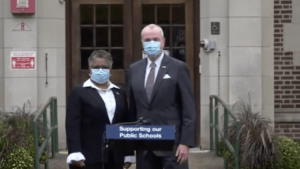Here’s a quote from a book review yesterday of Pulitzer Prize-winning author Eugene Robinson’s “Disintegration: The Splintering of Black America.” According to reviewer Raymond Arsenault, Robinson “demonstrates rather convincingly that no one belongs to the black community anymore.”
During the past four decades, Robinson persuasively argues, black America has splintered into four subgroups: the Transcendent elite; the Mainstream middle class, which now accounts for a majority of black Americans; an Emergent community made up of mixed-race families and black immigrants from Africa and the Caribbean; and the Abandoned, a large and growing underclass concentrated in the inner cities and depressed pockets of the rural South.
The educational implications of Robinson’s thesis seem pretty obvious: the children at greatest risk belong to the latter group. Jump right in, but the thesis rings true: the majority of black Americans are doing fine — in fact, their educational and economic progress, according to Robinson, is consistently under-rated – but the Abandoned group has “less hope of escaping poverty and dysfunction than at any time since Reconstruction’s crushing end.”
The big education news story today in NJ (stay with me here) is that the State Supreme Court will hear oral arguments on Wednesday regarding the constitutionality of the Christie Administration’s school aid cuts last winter. Remember, for thirty years the Education Law Center has been fighting for increased school funding for Abbott districts and for twenty years the Supreme Court has ordered that the State supply compensatory funding for poor students so that our poorest districts are funded at the same level as our wealthiest. (Former Gov. Corzine authorized the School Funding Reform Act, which directs money directly at students instead of districts, though it’s unclear whether that’s a distinction with a difference.) ELC is arguing that Christie’s decision to cut $820 million in school aid violated SFRA. The Christie Administration is arguing that the cuts were necessary given the fiscal crisis.
(There’s also all sorts of messy political wrangling involving Christie’s court appointments. We’ll stay out of that, but knock yourself out.)
In an article in today’s Philadelphia Inquirer, ELC’s Paul Trachtenberg casts the Court’s options as a moral conundrum: the Justices can either bow to political pressure from the Christie Administration or “uphold their principles.” In other words, this is not a fight about constitutionality or fiscal realities, but an ethical question regarding educational equity. But is it really (sorry) so black and white?
If Eugene Robinson is right, then this splintering of the black community – to whom much of the Abbott/SFRA funding is directed – has significantly increased over the last few decades. From his book:
These four black Americas are increasingly distinct, separated by demography, geography, and psychology. They have different profiles, different mind-sets, different hopes, fears, and dreams… More and more…we lead separate lives.
Yet, while traditionally oppressed and/or impoverished communities are evolving, our thinking about the nature of educational equity and the needs of poor students – Black, white, Hispanic, whatever – remains static. ELC and the Governor’s Office are having the same argument they had back in February 1981, the occasion of the first Abbott filing.
Now, SFRA (or the Abbott decisions, for that matter) never directed money on the basis of race but, rather, on the basis of poverty. However, Eugene Robinson’s description of the vastly-changed nature of Black America still raises questions of whether our discussions regarding educational needs in poor communities remain entrenched in 1980’s rhetoric.
Communities have changed. Maybe there are parts of Newark (or Camden or Paterson) where traditionally poor people are successfully vaulting over historical impediments, and other parts of these cities where the Abandoned class is mired in oppressive impoverishment, falling further and further behind.
In fact, some of the data bears this out. Look at the academic accomplishments of one cadre of kids at a public middle school in Newark. The students there are mostly Black (79 out of a class of 89) and mostly economically disadvantaged (75 kids out of 89). According to NJASK 8 results in language arts, 1.1% failed (“partially proficient,” says the euphemistic DOE), 76.4% were proficient, and 22.5% scored advanced proficient. According to the NJSASK 8 results in math, 8.3% of students failed, 60.2% scored proficient, and 31.5% scored in the advanced proficient range.
Now let’s take a second public middle school in Newark. The whole eighth grade is Black and half (35 out of 63) are economically disadvantaged. According to NJASK 8 results in language arts, 49.2% failed, 50.8% scored proficient, and 0% scored advanced proficient. According to NJASK 8 results in math, 65.1% failed, 33.3% scored proficient, and 1.6% scored in the advanced proficient range.
The first school is Robert Treat Academy, the well-regarded public charter school. The second school is Vailsburg Middle School, a traditional public school.
(FYI, total comparative cost per pupil at Vailsburg is $19,305. Total comparative cost per pupil at Robert Treat is $11,416)
The point is not whether public charters do a better job at educating poor kids than traditional public schools. Some do and some don’t. The point is that the arguments we’ve had in NJ over the past thirty years –- and the one slated to begin again on Wednesday in State Supreme Court – don’t reflect the changing realities of our “Abandoned” underclass and the educational needs of the children stuck in that swamp.
And maybe we have a bit more knowledge about what works and what doesn’t. A few examples: we know it’s not just about money. (We do know this by now, right?) We know that increases in instructional time, augmentative programming, and parental involvement help. We know that sometimes non-traditional public schools are more successful under certain circumstances. Shouldn’t some of this new knowledge inform deliberations about educational equity?
A New Year’s hope: that we know more about providing educational opportunities to disadvantaged children than we did thirty years ago, and that those empowered to fight for those children uphold not just principles but knowledge.



